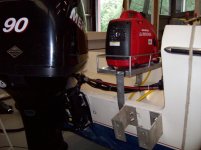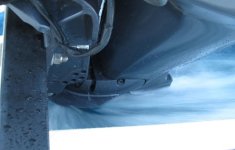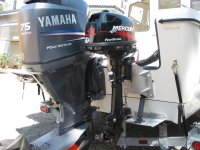I have a question for someone who took more math than I ever did. It has to do with my primary engine - Yamaha F80 - mounting.
So, right now when the engine is tilted all the way up (boat at rest), the tip of the skeg just barely touches the water when the boat has a cruising load. That's the baseline.
I'm going to raise the engine to its highest mounting hole, which is 1-1/2" higher than the one its in now. This is for performance reasons because my Perma Trim is much lower in the water than it should be (Roy & Dixie have same engine/same mounting, did the raise about a year ago, and say it was a definite improvement.) Okay, so that part is clear. But here comes the math...
There is another issue I'd like to address, which is that I am constantly all the way to one end of my trim range when above hull speed. I have to always have the engine trimmed all the way down. (This is independent of whether or not the bow is down, btw.) I asked Roy & Dixie and they said that even with the engine raised, they still have that same issue. Anything but all the way down is less good. So... who knows if that is the best position or not, because there is no way to trim past that to where it gets worse going that way, then trim back to the ideal position. You can only trim all the way down at which point it's the best it can be, but you can't tell if it could be better because you can't go any farther.
So to potentially address that, I got a pair of 5º "tuck" wedges - they simply fit between teh engine bracket and the transom and make the transom "5º more slanted." Thus engine trims down a bit more, and up a bit less. If I'm going to install these, I'd like to do it when I'm moving the engine up (am also going to overdrill/fill/re-drill the engine mount transom holes, as these are the last ones I have not done). Likely these would give me an actual adjustment range, wherein I could trim "too far" in either direction, then fine tune it to just right, performance-wise. That would be nice.
However.... I can't figure out what this combination would do to my "skeg level" when the boat is at rest and the engine is tilted all the way up. On the one hand, the 5º "tuck" wedge would lessen the amount I could trim the engine up at rest; but on the other hand I'm moving it up on the bracket 1-1/2". I can see what either of these would do alone, but with them both done, where do I end up in comparison to where I am now for skeg height with "engine at rest and tilted all the way up"? I'm sure there is some math I could have learned in school to figure it out in advance :crook - but I didn't.
BTW, the tilt degree on the Yamaha F80 is not shown in the specs, but the current 75/90 I believe have the same bracket/tilt mechanism and they show a 65º maximum tilt.
If math fails, I will try it with cardboard mockups
So, right now when the engine is tilted all the way up (boat at rest), the tip of the skeg just barely touches the water when the boat has a cruising load. That's the baseline.
I'm going to raise the engine to its highest mounting hole, which is 1-1/2" higher than the one its in now. This is for performance reasons because my Perma Trim is much lower in the water than it should be (Roy & Dixie have same engine/same mounting, did the raise about a year ago, and say it was a definite improvement.) Okay, so that part is clear. But here comes the math...
There is another issue I'd like to address, which is that I am constantly all the way to one end of my trim range when above hull speed. I have to always have the engine trimmed all the way down. (This is independent of whether or not the bow is down, btw.) I asked Roy & Dixie and they said that even with the engine raised, they still have that same issue. Anything but all the way down is less good. So... who knows if that is the best position or not, because there is no way to trim past that to where it gets worse going that way, then trim back to the ideal position. You can only trim all the way down at which point it's the best it can be, but you can't tell if it could be better because you can't go any farther.
So to potentially address that, I got a pair of 5º "tuck" wedges - they simply fit between teh engine bracket and the transom and make the transom "5º more slanted." Thus engine trims down a bit more, and up a bit less. If I'm going to install these, I'd like to do it when I'm moving the engine up (am also going to overdrill/fill/re-drill the engine mount transom holes, as these are the last ones I have not done). Likely these would give me an actual adjustment range, wherein I could trim "too far" in either direction, then fine tune it to just right, performance-wise. That would be nice.
However.... I can't figure out what this combination would do to my "skeg level" when the boat is at rest and the engine is tilted all the way up. On the one hand, the 5º "tuck" wedge would lessen the amount I could trim the engine up at rest; but on the other hand I'm moving it up on the bracket 1-1/2". I can see what either of these would do alone, but with them both done, where do I end up in comparison to where I am now for skeg height with "engine at rest and tilted all the way up"? I'm sure there is some math I could have learned in school to figure it out in advance :crook - but I didn't.
BTW, the tilt degree on the Yamaha F80 is not shown in the specs, but the current 75/90 I believe have the same bracket/tilt mechanism and they show a 65º maximum tilt.
If math fails, I will try it with cardboard mockups





